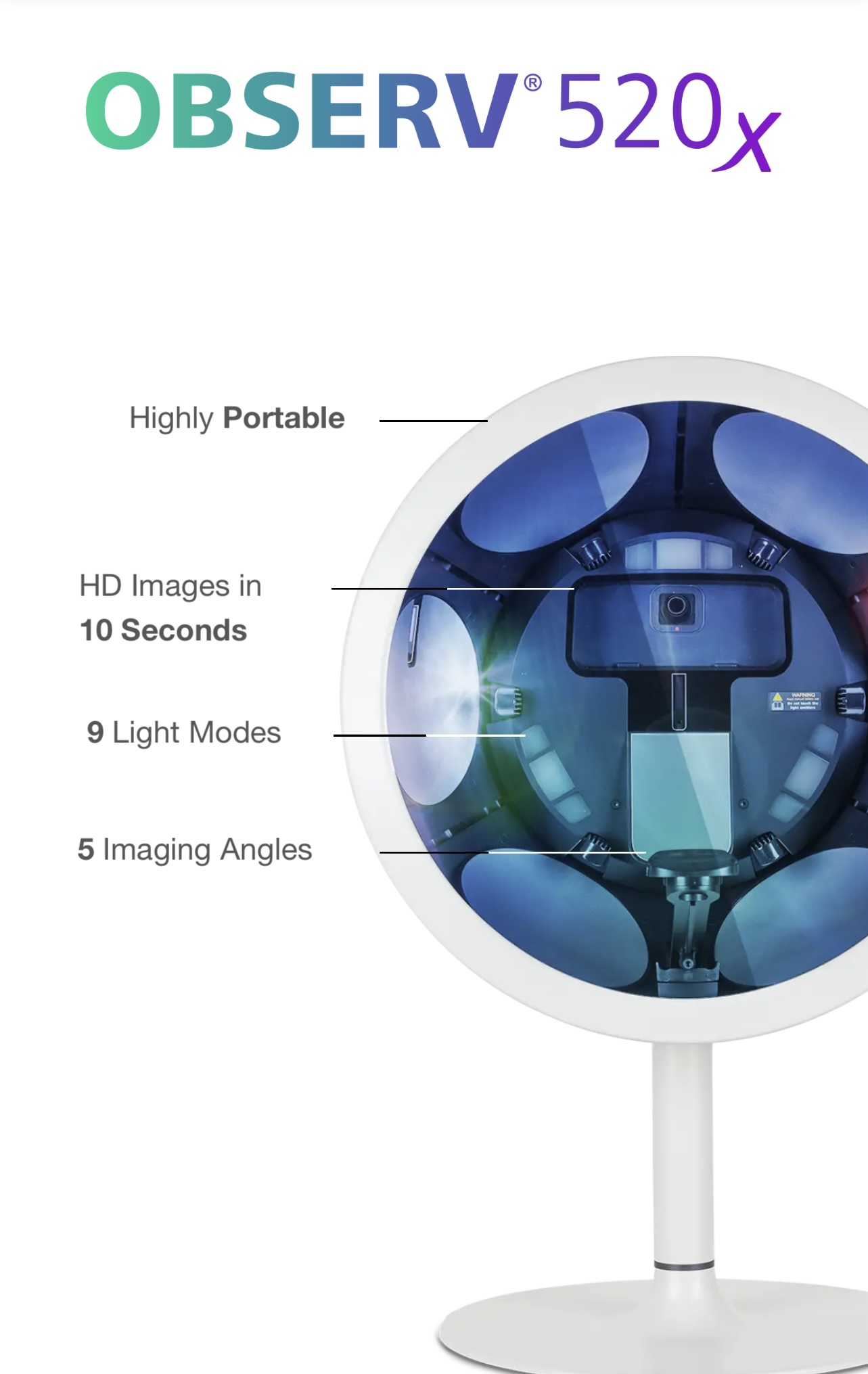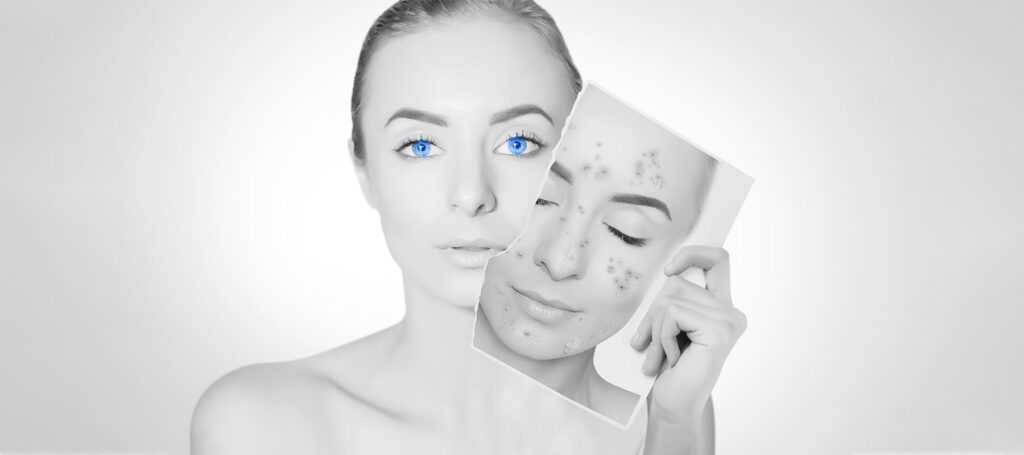Understanding The Layers Of Your Skin: A Deeper Dive
Many skin conditions originate from the deeper layers of the skin, making accurate diagnosis at times difficult with just the human eye. That’s why we’re thrilled to introduce a new diagnostic system to enhance our clients’ experience, consultation process, and treatment plan development.
The Three Main Layers of the Skin
- Epidermis: The outermost layer of your skin is composed of corneal cells, keratinocytes, and melanocytes. This layer acts as a protective barrier against external elements. The skin’s continuous renewal process begins in the epidermis, with keratinocytes forming at the base and migrating toward the surface, while melanocytes are responsible for skin pigmentation.
- Dermis: Beneath the epidermis lies the dermis, which houses sweat glands, hair follicles, sebaceous glands, and blood vessels. Sweat glands help regulate body temperature, while hair follicles play a role in temperature regulation and sweat distribution. Sebaceous glands produce lipids, contributing to the skin’s moisture and overall health.
- Subcutaneous Layer: The deepest layer consists of connective tissue and fat, which acts as insulation and a shock absorber.
The Importance of Healthy Skin
Healthy skin is characterized by a harmonious, radiant glow. When your skin is in its prime condition, the light emitted by various skin analyzers scatters evenly through the tissue. This healthy fluorescence effect originates from collagen and elastin tissues, illuminating your skin from within. In such cases, none of the light rays are absorbed by clustered pigments or impaired skin tissue.
Introducing the Observe 520x Diagnostic System
With our new skin diagnostic tool, the Observe 520x, we are excited to offer an enhanced analysis of skin texture, colorations, and secretions. This innovative system allows us to provide a more comprehensive assessment, leading to more specific and unique treatment plans tailored to each client’s needs.
Skin Texture Analysis
When we observe skin texture, we are looking for disturbances in the keratinization process, the loss of structural integrity, infections, inflammation, as well as issues related to adhesion and resilience. The Observe 520x enables us to delve deeper into the layers of your skin, revealing critical information that might not be apparent to the naked eye.
Skin Coloration Analysis
Analyzing skin colorations with our diagnostic tool offers a more profound understanding of pigmentation disorders, inflammatory responses, and vascular disorders. This knowledge allows our treatment providers at Dccm to conduct a thorough and detailed analysis of the skin, leading to the development of highly specific treatment plans.
Skin Secretions Analysis
Skin secretions play a vital role in skin health. Our diagnostic equipment helps us identify essential fatty acid deficiencies, impaired acid mantle, acne, and bacteria. Understanding these factors enables us to design treatment plans that target the root causes of skin issues.
understanding Skin Analyzers And Their Light Modes
Skin analyzers are invaluable tools for assessing the condition of your skin. They employ various light modes to reveal a wealth of information:
- Daylight Mode: This mode provides controlled daylight conditions to make comparisons with other light modes, aiding in the diagnosis of different skin conditions.
- True UV Light Mode: True UV light makes skin cells’ fluorescence behavior more distinguishable, revealing hidden details.
- Woods Light Spectral Composition: This mode helps identify various skin problems, including bacterial and fungal infections, porphyria, skin coloring changes, and some skin cancers.
- Cross Polarized Mode: This mode suppresses surface glare, allowing for a direct view inside the skin and revealing vascular and pigmentation disorders.
- Parallel Polarized Light Mode: This mode enhances the visibility of the skin’s surface textures, fine lines, and wrinkle formations, aiding in diagnosing skin conditions.
skin Conditions And Their Impact On Diagnostic Results
Understanding the layers of your skin, as well as the diagnostic information obtained through skin analyzers, can offer insights into various skin conditions:
- Pigment Formation: The skin’s color is influenced by melanin production. Exposure to UV radiation triggers melanogenesis, leading to visible tanning. Hormones or skin inflammation can stimulate melanocytes, resulting in uneven skin color.
- Sun Damage: Conditions like solar lentigines, freckles (ephelides), and chloasma/melasma can be indicative of repeated sun exposure. Regular dermatology checks are advisable.
- Vitiligo: This loss of pigmentation typically has a genetic predisposition and can affect all skin types, resulting in uneven skin color.
- Epidermal Textures: Surface conditions such as dry skin, hyperkeratosis, and poor corneocyte compaction can affect the skin’s texture and appearance.
- Secretions and Oil Flow: Understanding the distribution of sebaceous and sweat gland secretions can help identify issues such as sluggish oil flow, open pores, and oily skin.
- Dermal Textures and Colors: Changes in the dermis, like loss of structural integrity and diffused redness, can affect the skin’s texture and color.
- Scarring: The formation and quality of scars depend on various factors, including genetics and the type and severity of the injury.
- Infections and Inflammations: Skin analyzers can differentiate between conditions like eczema and fungal infections, facilitating proper treatment.
preparation For Your Skin Consult Appointment
To ensure the most accurate diagnosis and treatment plan, we kindly ask our clients to arrive makeup-free and without any creams or serums applied to your skin. We aim to obtain a true representation of your skin’s condition, allowing us to provide you with the best possible care and personalized treatment plan.
By delving into the intricacies of your skin, understanding its layers, and utilizing advanced diagnostic tools, we are committed to enhancing your skincare experience and empowering you with the knowledge and treatments needed to maintain healthy, radiant skin. Remember, healthy skin is not just about appearance but also a reflection of your overall well-being.
book Your Skin Scope Analysis Here!
[ngg src=”galleries” ids=”4″ display=”basic_thumbnail” thumbnail_crop=”0″]



